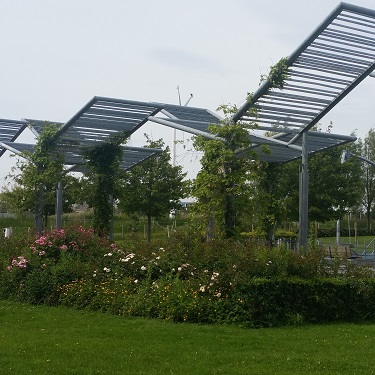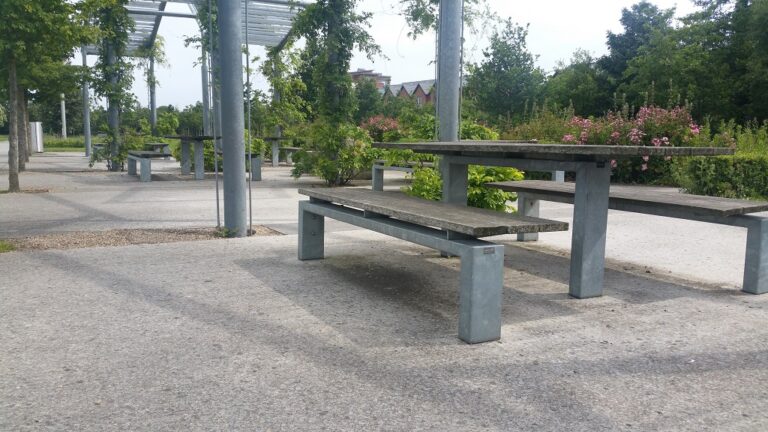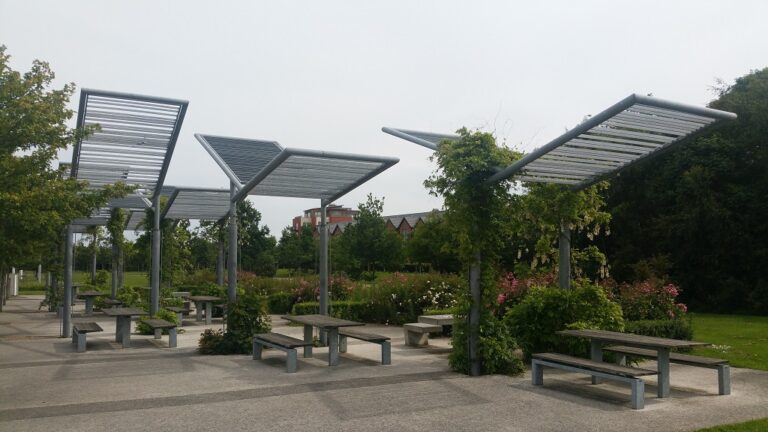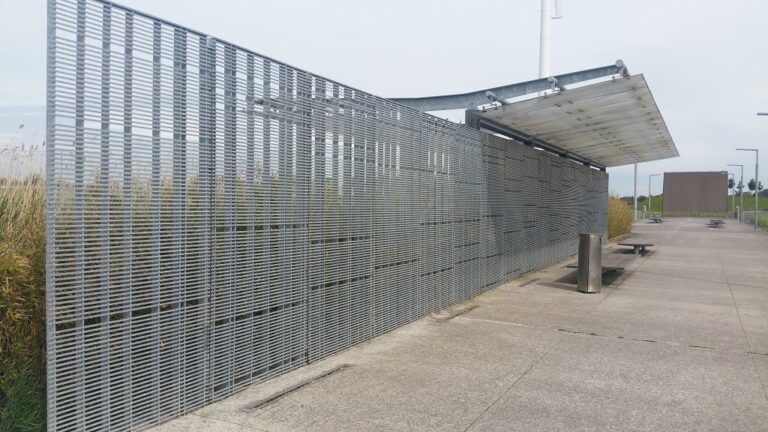Fr. Collins Park is Ireland’s first wind powered and wholly sustainable park, and was designed by the Argentinian architects Abelleyro & Romero. It has the capacity to be entirely energy self-sufficient with five wind turbines that harness the wind and provide the energy that powers the park’s lighting, aeration and water features as well as the maintenance depots and sports changing rooms.
The park has since won a number of awards such as The Sustainability Award 2010, Best Public Space 2010, and Best Public Park & Best Environmentally Friendly Initiative for 2010 and was short listed by the European Union Prize for Contemporary Architecture 2011.
The approximately 54 acres (or 26 hectares) encompasses some natural woodlands, a 1.5 km peripheral running/cycling track, six playing pitches and six fitness stations, a promenade, a concert amphitheatre and picnic areas with outdoor chess/draughts boards, and two playgrounds and a skate-park.
It also includes sustainable features such as wetlands which treat and store surface water from the park to prevent run-off, and a green roof on the sports pavilion.
A central part of the design brief was to establish in the population the awareness of the rational use of non-renewable natural resources, and to put the Dublin commune as a pioneer in the construction of self-sustainable public spaces, and respect for the environment. This required the use of construction materials that would provide low maintenance cost and great corrosion resistance over time.
Choice of Materials
Hot Dip Galvanized Steel was used throughout the park for this precise reason. Firstly, it is a natural product, combing two of the earth’s most common elements, zinc and iron. More importantly, it’s toughness and durability mean that it can deliver a maintenance free life far in excess of the normal 50 years design life.
The Hot Dip Galvanizing standard I.S. EN ISO 1461:2022, requires a mean coating thickness of 70 microns on 3-6mm steels and 85 microns on steels of 6mm and above. Atmospheric corrosion data obtained in the Zinc Millennium Map project of 2000, suggests an annual corrosion rate of 0.5 microns in the greater Dublin area, giving galvanized steel a potential lifetime of 140-170 years.
On the 10th Anniversary of the park’s opening we thought it would be interesting to see how well the galvanized steel elements are performing. In order to do this, we carried out coating thickness measurements across a wide range of items including gates, railings, sun shades, screens and bridges.
The results were amazing, with all readings still being well in excess of the required standard and many well in excess of 100 microns. This is remarkable after 10 years and clearly demonstrates that the choice of Hot Dip Galvanized Steel has more than delivered on the design requirements. No maintenance will be required on most of this steelwork for the remainder of this century and beyond!
If the park is re-designed in the future or if for any reason the steelwork is no longer required, it can be easily taken down for re-use elsewhere or fully recycled. In the recycling process the zinc can be easily separated from the steel in the melting process and both the zinc and steel can be re-used without loss of their inherent qualities.
Fr. Collins Park
Client: Dublin City Council
Parks & Landscapes Services Division
Block 4, Ground Floor,
Civic Offices,
Fishamble Street
Dublin 2
Enquiries: (01) 222 5278
Architect: Argentinean Architects Abelleyro & Romero
Project Managers: MCO Projects
Main Contractor: Liffey Developments
Landscape Designers: Cunnane Stratton Reynolds
Landscaping Contractor: Peter O’Brien & Sons
Value: €20m
Commenced: Sept 2007
Completed: May 2009
Project Gallery
Background Information
Declared a Statutory Nature Reserve in 1988, the inner estuarine part of the estuary and wetlands of Baldoyle Bay are of high significance protected as a Special Area of Conservation (SAC). They support several habitats that are listed on the EU Habitats Directive[8]. Under the Ramsar Convention, it is designated as a wetland of international importance.
Consequently, during the seasons of migration, the open lands of Father Collins Park continue to host migrating birds. Undisturbed lands remain an important refuge and hub for Arctic and European migratory birds. Of particular interest is the internationally important population of Brent Geese which inhabit the estuary.
Features of the park include:
- A large lake and central promenade with 3 shelters offering shade and protection from the weather
- An inbuilt stage and amphitheatre to the north provide panoramic views of the entire park and cater for outdoor theatre and concerts
- Five grass pitches with changing room facilities together with a 1.5km circuit track for cycling, running and walking
- Six health stations interspersed along its perimeter for those interested in ‘working out’
- Children of different age groups can play in two playgrounds constructed on safe flexible surfaces made from recycled runners, while seated areas with permanent chess and draughts boards are provided for budding grandmasters
- Picnic sites are available in attractively landscaped areas with grassland areas dedicated for casual pursuits like walking, playing football and ‘frisbee’ etc.
- A plaza design skate park, the first of its type and size in Ireland, was designed for street skaters using 3 levels containing a variety of steps, edges, straight lines and grind rails
- Wetland areas contain and treat park water within a series of reed beds, as part of a recycling system that will both replenish and keep the main water feature clean; these wetlands will contribute to the existing ecosystem, encouraging biodiversity within the park









